For weeks, for months, one country is at the centre of the world, of the football world, but perhaps also of the wine world: South Africa. I am not the only one who is now thinking about, encountering and writing about this country and its wines. For the first time, actually. Maybe it's the 80 or so years of apartheid politics - first under the English, then (after World War II) under the Boers - which still weigh on my relationship with South Africa, including my relationship with South African wine so far.
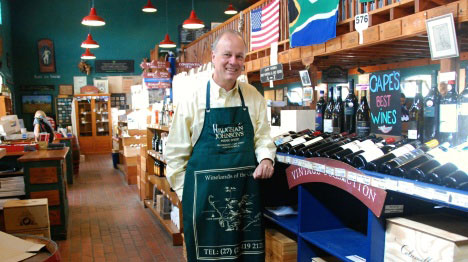
|
| Vaughan Johnson presents 5000 South African wines in his Wine Shop at the Waterfront in Cape Town. |
On February 11, 1990 - 20 years ago - Nelson Mandela, who was released shortly before after 27 years of imprisonment, gave his "historic speech" from the balcony of City Hall in Cape Town; "Friends, comrades and fellow citizens of South Africa. I greet you all in the name of peace, democracy and freedom for all. I stand here before you not as a prophet, but as a humble servant, before you, the people." Four years later, Mandela becomes President of South Africa, and the politics of segregation are finally over. Today, 16 years later, the country welcomes the world of football and is thus ennobled with the "high consecration of international understanding through sport".Why this historical digression in a wine column? Quite simply: because now I, too, can again bite heartily into the Granny Smith sour apple - once a symbol of morally reprehensible economic relations - and drink "Pinotage", the South African wine, without a guilty conscience. If it nevertheless took me almost twenty years to travel to South Africa for the first time, then it is not so much the 8,000 kilometres by air that are to blame, but rather the inner distance to a country that for so long (with the support of many state, economic and industrial powers) was able to pursue a policy against people - against the indigenous people of the country.
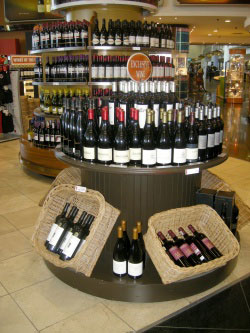
|
| Presentation of South African wines at the airport in Johannesburg. |
But now I have been there - in the most important wine region of Africa. There, where the wines, which have been available in all price ranges and qualities for long, come from and where most of them try to be good wines on their own. Among them, the Pinotage, vinified out of a grape variety newly bred in Stellenbosch 86 years ago (a cross between Cinsault and Pinot Noir). It is a symbol for the independence of the country and its wines. Actually, far more grape varieties are cultivated in South Africa today. They are - analogous to the "big five" of the animal world - above all the "big six" of the grape varieties: Sauvignon Blanc, Chardonnay, Cabernet Sauvignon, Merlot, Shiraz and Pinot Noir.
The fact that South Africa has managed to become one of the world's leading wine nations can easily be registered and verified even without visiting the country. Descriptions of the wines from South Africa have long been provided by professional tasters and amateurs. Should I now copy, repeat, differentiate or simply confirm?

|
| Magic of place. The new soccer stadium in Cape Town. |
My involvement with South African wines is to expand my own wine knowledge and experience; to see with my own eyes; to test in my own palate; to compare with my own senses; but not to publish.
It is something else entirely that has defined my presence in South Africa: it is the "magic of place". Why do I go to Cape Agulhas, the geographical boundary between the Indian Ocean and the Atlantic? Why do I visit Groote Schuur Hospital in Cape Town, where Christian Barnard performed the first heart transplant 43 years ago? Why do I stop under the balcony of the City Hall in Cape Town where Nelson Mandela gave his famous speech? Why am I trying to get to the former prisoner Robben Island at all costs? Why?
Not because there is so much to see there, but rather to experience and feel the place where world history has happened (or is happening), where something is happening that can or could only happen here. Magic of the place! This also applies to famous wine regions, important wineries, unique vineyards.
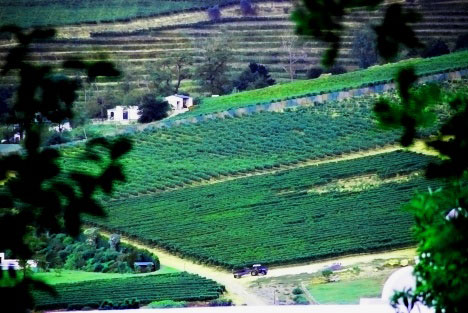
|
| Constantia in Cape Town% the oldest wine region in South Africa. |
I am sitting in the city sightseeing bus in Cape Town, in my headphones the list of sights whizzing past me: Kirstenbosch Gardens - World of Birds - Inizano Yethu - Mariner's Wharf. At some point the name "Constantia" appears. Isn't that where South Africa's first wineries were located? Wasn't this once the empire of Simon van der Stel, seven vineyards planted in the 17th century? I stretch and stretch, wanting to see at least a little bit of it through the green of the forest. Magic of the place. Gone: We only tangentially touched Constantia. But we were there, and I decide to visit not only Constantia and Stellenbosch, but a few other historic wine regions like Calitzdorp, the port wine town, in the "little Karoo".
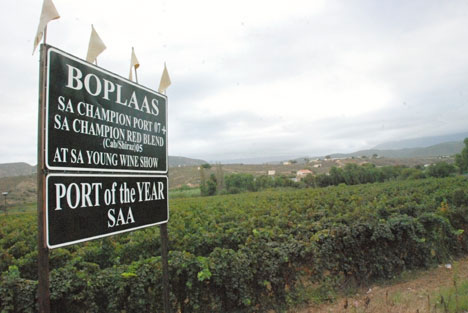
|
| Vineyards in Calitzdorp% in the "little Karoo"% where South African port is made. |
I don't have too much time, because we don't only want to see the "bigsix of wines", but also - much further in the east of the country - the "bigfive" of animals. Why all this, in the few weeks that are already filled with flights and car trips? It's about the same question as, "Why make a pilgrimage to South Africa to watch some World Cup games, way up in the huge stadium, while on TV everything is shown much closer, much more present, much more accurate?" The answer here, too: Magic of place. In the football stadium, it is the atmosphere of being there at the moment of the final goal and victory, or even experiencing defeat up close.
In the wine villages, in the vineyards, in the wineries, it is no different: to be there when the vines are being tended, when wine is being vinified, when wine is being tasted, where it was made. To be there where people who make wine work and live. To see how a winery presents itself and how it offers its wines, to receive the foreign wine lover, and to experience how a wine can be enjoyed in the place where it was made.
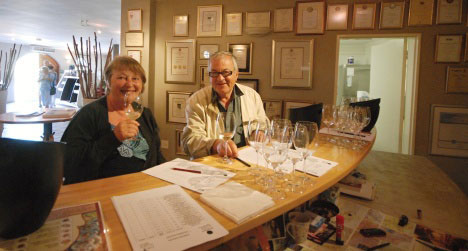
|
| The columnist with his partner at the tasting at the "Kanu" wine estate near Stellenbosch. |
Basically, a tasting of South African wines there is not much different than in a wine cellar at home, in a wine shop with a good offer of South African wines. Maybe the judgement at home is even more "objective" because you can gather more information and spend more time there. Just like the soccer fan at home in front of the screen or the wine tester in a worldwide organized Twitter event can do. Only one thing is missing: the magic of place. The physical presence, at the place where something is happening or has happened; where the atmosphere of a place can perhaps convey something of what can otherwise only be captured in facts and figures. Even if it sounds a bit strange: I experience and enjoy a Pinotage in South Africa just differently than the same wine at home. That's why I didn't take any wine from South Africa with me, not even a Pinotage. I brought it - and many other wines - only in my heart, as an experience and as a memory. There they remain, much longer than in the cellar; they have a much, much more intense effect than the one in the bottle, even once it is opened and the wine spreads its fragrance and gives pleasure to the palate.
Cordially
Yours sincerely